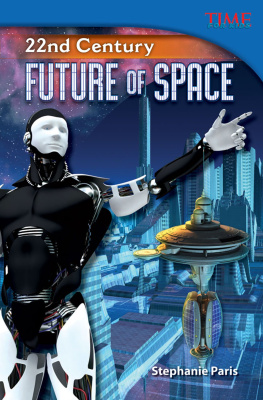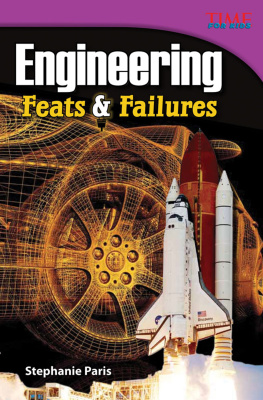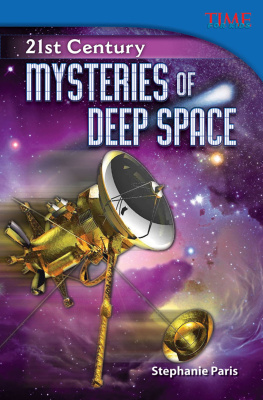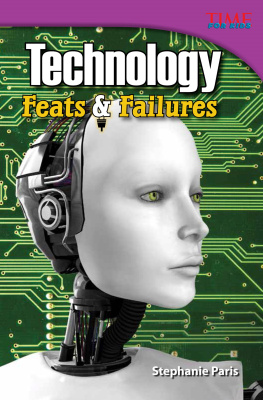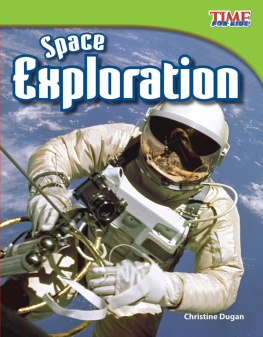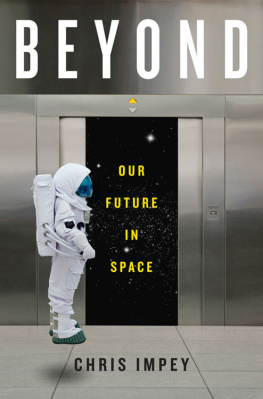
22nd Century
Future
of
Space Future
of
Space
Stephanie Paris


Consultants
Timothy Rasinski, Ph.D.
Kent State University
Lori Oczkus
Literacy Consultant
Based on writing from
TIME For Kids. TIME For Kids and the TIME
For Kids logo are registered trademarks of
TIME Inc. Used under license.
Publishing Credits
Dona Herweck Rice , Editor-in-Chief
Lee Aucoin , Creative Director
Jamey Acosta , Senior Editor
Lexa Hoang , Designer
Stephanie Reid , Photo Editor
Rane Anderson , Contributing Author
Rachelle Cracchiolo , M.S.Ed., Publisher
Image Credits: pp.18, 38, 49 (bottom)
iStockphoto; pp.23, 6, 67, 16, 1617,
4647, 5657 NASA; pp.10, 1011, 17, 25,
34 (bottom) PhotoResearchers Inc.; p.15
REUTERS/Newscom p.22 TVO/Newscom
pp.3435 (steps1-4) Daein Ballard
(CC BY-SA); pp.1213, 23, 2831, 4043,
4647 (illustrations) Timothy J. Bradley;
All other images from Shutterstock.
Teacher Created Materials
5301 Oceanus Drive
Huntington Beach, CA 92649-1030
http://www.tcmpub.com
ISBN 978-1-4333-4901-0
2013 Teacher Created Materials, Inc.
Teacher Created Materials
5301 Oceanus Drive
Huntington Beach, CA 92649-1030
http://www.tcmpub.com
2013 Teacher Created Materials, Inc.
Synched Read-Along Version by:
Triangle Interactive LLC
PO Box 573
Prior Lake, MN 55372
ISBN-13: 978-1-68444-970-5 (e-book)

Table of Contents
The Future of Space .............
New Technology ................
New Worlds ...................
New Neighbors ................
New Universes ................
Glossary ......................
Index ........................
Bibliography .................. 62
More to Explore ...............
About the Author ..............

The
Future
of
Space
In the movies, humans often explore deep space.
They travel faster than the speed of light. Landing
on strange planets and meeting aliens is all in a
days work.
In real life, technology is limited. But scientists
are searching for habitable planets. They are
looking for signs of intelligent life . And they are
working on making space travel much faster so we
can travel greater distances. But three things need
to happen before we can travel into deep space as
they do in the movies. First, we need to travel much
faster. But we cant go far without fuel. And fuel
is heavy. Somehow, we must power long-distance
voyages without running out of fuel. And finally,
we need to power the space vehicle once its in
space. Today, scientists are focused on making
breakthroughs on these three problems.

What breakthroughs in
technology will help us
travel deeper into space?
What new technologies
will help us build better
space vehicles?
What might we find as we
travel into space in the
22nd century?

Its hard to say what will happen. Not even the
National Aeronautics and Space Administration
(NASA) plans more than years ahead! But all the
ideas in this book are based on real science. Life today
is very different than it was a hundred years ago. And
its hard to know what will happen in the next hundred
years. One thing is certain. Much of what is science
fiction today will be reality tomorrow.
How Far
Weve Gone
The space probe Voyager
has traveled farther than any
other spacecraft from Earth.
It took over years for it
to reach the edge of our
solar system.
Voyager

How Far is Far?
A light-year is equal to the distance light
travels in one year, about 5.8 trillion miles.
Proxima Centauri
4.2 light-years away from Earth
moon
0.0000000406
light-years from
the sun
sun
0.000016 light-years from Earth

New Technology
New inventions can be simple or complex. But the
best ones make our lives easier. They allow us to do
things we couldnt do before. Today, we no longer rely
solely on telescopes to learn about space. Now, we can
send rockets into space. We can land robots on distant
planets. Humans can live on space stations. And this is
just the beginning.
New technology comes from new ideas. Nearly every
invention requires creativity. Mistakes will be made.
But there will also be successes. Scientists are merging
current technology with imagination. They plan to invent
technology that is out of this world!
Futurists
Futurists are people who
take what we know today
and try to imagine where it
might lead in the future. Not
everything they come up with
happens, of course. But their
ideas often guide research
going forward.

Past Predictions
In the past, futurists predicted that by today we
would have:
flying cars
computers in every home
time machines
electronic money
cities in the sky
shopping by computer
artificial human organs
intelligence pills
Which of their predictions have come true so far?

